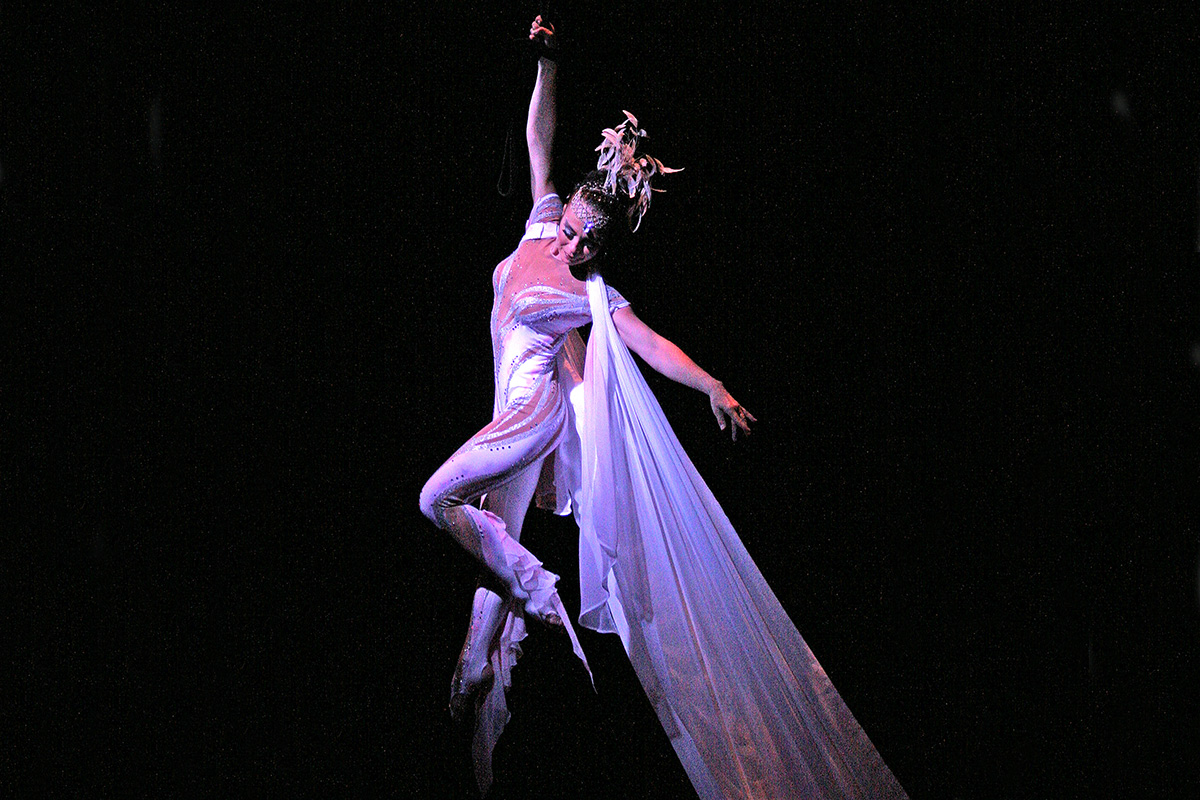The View from the (Big) Top: Dolly Jacobs’s Climb to Circus Royalty

According to aerialist Dolly Jacobs, creating a circus act is “like making a cake.” A single performance’s many ingredients—the acrobatics skills, the entrance, the costume, the music, the drama—all contribute to the spectacle. She knows this firsthand: the finale of her Roman rings act, her signature “flyaway somersault” from the rings toward a distant suspended rope, is nothing less than spectacular.
The act is expertly crafted to take spectators on a rollercoaster ride of fear and awe. Jacobs moves slowly with fluidity, concealing the magnitude of her act’s difficulty while simultaneously emphasizing its danger. Jacobs’s only sense of security comes from her setter, the person controlling her rope from the ground, who she trusts to deploy the rope just as she needs to catch it. The resulting act impresses circus novices and seasoned professionals alike, a masterpiece of circus craft steeped in techniques that have wowed audiences for decades.
Jacobs grew up in Sarasota, Florida, dubbed the “circus capital of the world” after the Ringling Bros. moved their winter quarters there in 1927. She has spent her life surrounded by circus, including four years with Sailor Circus, a youth program she now runs with her husband and fellow aerialist Pedro Reis. Just like any other kid at the circus, she was enthralled, a little afraid, and very much in awe of the performers she idolized. She still treasures an autograph book she began compiling as a child, which is filled with the signatures of these nowimmortalized performers.
One of her earliest inspirations was Dora “Rogana” Foster, a sword balancer. As part of her act, Rogana balanced a tray of filled drinking glasses on the hilt of a sword, which was itself balanced on the point of a dagger that she held in her mouth. She maintained all of this while climbing up and down a swaying forty-foot ladder. Jacobs remembers being captivated by her beauty, poise, and elaborate costumes.
“I knew, in my heart of hearts, that I was going to be in the ring, and be as great as that woman,” she recalls.


Though impressive performers abounded in Sarasota, Jacobs had no shortage of role models in her own family. Her father, Lou Jacobs, was a world renowned clown who performed with Ringling Bros. and Barnum & Bailey Circus for over sixty years. He is best remembered for his small clown car, which he doubled himself inside, and for his iconic image that represented Ringling Bros. and Barnum & Bailey for decades.
Her father was a great inspiration to her, and they enjoyed a very close relationship. When her father stepped into the tent to perform, she remembers that “he owned the ring.” They delighted in watching each other’s acts, beaming with pride from the sidelines.
Her mother, Jean Rockwell, was one of the top ten Conover models in New York before joining Ringling Bros. and Barnum & Bailey as a showgirl and dancer. Her godmother, Margie Geiger, was a ballet dancer from New York who joined the Ringling Bros. and Barnum & Bailey and married a member of the legendary Flying Wallendas. Geiger introduced Jacobs to the Roman rings apparatus and helped her develop her first solo act.
Regardless of her family’s history, she insists, “Nothing was given to me except inspiration, coaching, and a wonderful upbringing.” The circus rewards hard work, she adamantly asserts.
At age fourteen, Jacobs joined the circus as a showgirl. Being raised in and by the circus, she explains, was an incredible and unique experience. She, her parents, and the other performers lived on a train, a long-standing Ringling tradition. She was homeschooled for four to five hours a day, all the while being exposed to countless American cities, towns, and cultural landmarks that most children only read about. She had always been very shy, she remembers, but the circus encouraged her to interact with people from all over the world and eventually come out of her shell.


She and the other showgirls rode horses and elephants, danced, and performed aerial acts in groups. In their dressing rooms, her fellow performers taught her how to sew, knit, cook, and mend costumes, skills they brought from their diverse backgrounds. As a result, she is fluent in Bulgarian and Spanish and speaks some Polish and German.
The circus also instilled in Jacobs an unwavering sense of self-confidence, which she works hard to help her students find today. “You can’t teach self-pride,” she observes. “That’s something you have to earn.” And there’s no better place to earn it than the circus.
Jacobs emphasizes, above all else, immense gratitude for the performers who have come before her. The circus arts, like any form of folk art, are sets of skills passed down through generations. She acknowledges that her predecessors opened the gateway to a multitude of circus and performance knowledge, passing on techniques they were taught by the previous generation.
In September 2015, when she accepted the NEA National Heritage Fellowship—the first circus artist to do so—she insisted, “This is not for me. It’s for them.”
Without a doubt, when Jacobs’s students achieve incredible feats in their own careers, they will acknowledge her with the same reverence.
See Dolly Jacobs perform at the 2017 Folklife Festival in Washington, D.C., June 29 to July 9!
Caroline Glazer is a student at Carleton College. She interned at the Center for Folklife and Cultural Heritage in December 2016 and interviewed Dolly Jacobs for a feature in the upcoming July/August issue of FACES magazine. Circus Arts program intern Marissa Walker also contributed to the piece.
